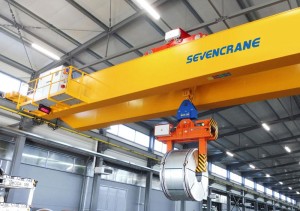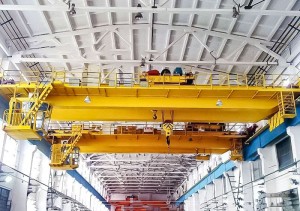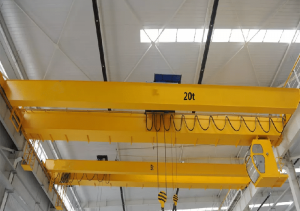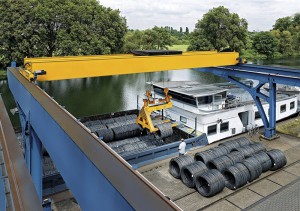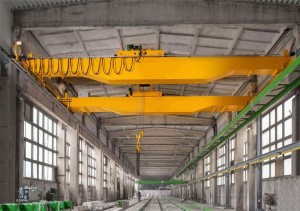
Double girder bridge crane for lifting heavy objects
Components and Working Principle
Components of a Large Bridge Crane:
- Bridge: The bridge is the main horizontal beam that spans the gap and supports the lifting mechanism. It is typically made of steel and is responsible for carrying the load.
- End Trucks: The end trucks are mounted on either side of the bridge and house the wheels or tracks that allow the crane to move along the runway.
- Runway: The runway is a fixed structure on which the bridge crane moves. It provides a path for the crane to travel along the length of the workspace.
- Hoist: The hoist is the lifting mechanism of the bridge crane. It consists of a motor, a set of gears, a drum, and a hook or lifting attachment. The hoist is used to raise and lower the load.
- Trolley: The trolley is a mechanism that moves the hoist horizontally along the bridge. It allows the hoist to traverse the length of the bridge, enabling the crane to reach different areas within the workspace.
- Controls: The controls are used to operate the bridge crane. They typically include buttons or switches for controlling the movement of the crane, hoist, and trolley.
Working Principle of a Large Bridge Crane:
The working principle of a large bridge crane involves the following steps:
- Power On: The operator turns on the power to the crane and ensures that all controls are in the neutral or off position.
- Bridge Movement: The operator uses the controls to activate the motor that moves the bridge along the runway. The wheels or tracks on the end trucks allow the crane to travel horizontally.
- Hoist Movement: The operator uses the controls to activate the motor that raises or lowers the hoist. The hoist drum winds or unwinds the wire rope, lifting or lowering the load attached to the hook.
- Trolley Movement: The operator uses the controls to activate the motor that moves the trolley along the bridge. This allows the hoist to traverse horizontally, positioning the load at different locations within the workspace.
- Load Handling: The operator carefully positions the crane and adjusts the hoist and trolley movements to lift, move, and place the load at the desired location.
- Power Off: Once the lifting operation is complete, the operator turns off the power to the crane and ensures that all controls are in the neutral or off position.
Features
- High Lifting Capacity: Large bridge cranes are designed to have a high lifting capacity to handle heavy loads. The lifting capacity can range from several tons to hundreds of tons.
- Span and Reach: Large bridge cranes have a wide span, allowing them to cover a large area within the workspace. The reach of the crane refers to the distance it can travel along the bridge to reach different locations.
- Precise Control: Bridge cranes are equipped with precise control systems that enable smooth and accurate movements. This allows operators to position the load with precision and minimize the risk of accidents.
- Safety Features: Safety is a critical aspect of large bridge cranes. They are equipped with various safety features such as overload protection, emergency stop buttons, limit switches, and collision avoidance systems to ensure safe operation.
- Multiple Speeds: Large bridge cranes often have multiple speed options for different movements, including bridge travel, trolley movement, and hoist lifting. This allows operators to adjust the speed based on the load requirements and workspace conditions.
- Remote Control: Some large bridge cranes are equipped with remote control capabilities, allowing operators to control the crane from a distance. This can enhance safety and provide better visibility during operations.
- Durability and Reliability: Large bridge cranes are built to withstand heavy-duty usage and harsh working environments. They are made from robust materials and undergo rigorous testing to ensure durability and reliability.
- Maintenance and Diagnostic Systems: Advanced bridge cranes may have built-in diagnostic systems that monitor the crane’s performance and provide maintenance alerts or fault detection. This helps in proactive maintenance and reduces downtime.
- Customization Options: Manufacturers often offer customization options for large bridge cranes to meet specific customer requirements. This includes features such as specialized lifting attachments, additional safety features, or integration with other systems.







After-Sale Service and Maintenance
After-sales service and maintenance are crucial to the long-lasting operation, safety performance and reduced risk of failure of overhead cranes. Regular maintenance, timely repairs and spare parts supply can keep the crane in good condition, ensure its efficient operation and prolong its service life.





